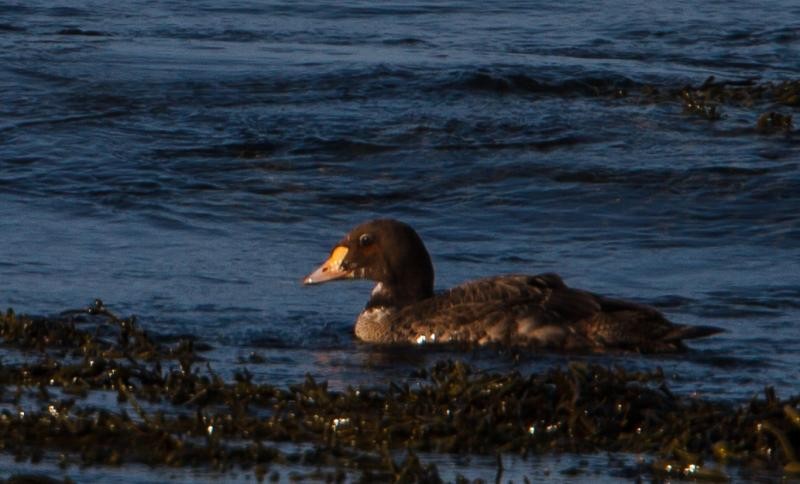King Eider
A species of Typical Eiders Scientific name : Somateria spectabilis Genus : Typical Eiders
King Eider, A species of Typical Eiders
Botanical name: Somateria spectabilis
Genus: Typical Eiders
Content
Description People often ask General Info
Description
The king eider is a large sea duck, measuring 50–70 cm (20–28 in) in length with a wingspan of 86–102 cm (34–40 in). Males are, on average, heavier than females, with a mean weight of 1.668 kg (3.68 lb) for males and 1.567 kg (3.45 lb) for females. An individual bird's mass can vary considerably from season to season—from as little as 0.9 kg (2.0 lb) to as much as 2.2 kg (4.9 lb). Like all eiders, the species is sexually dimorphic; the male is slightly larger and, in breeding plumage, much more colourful than the female. The male is unmistakable with its mostly black body, buff-tinged white breast and multicoloured head. The head, nape and neck are a pale bluish grey. The cheek is pale green. The bill, separated from the face by a thin black line, is red with a white nail and a large, distinctive yellow knob. Some tertials are curved up and form "spurs" along the back. The female (occasionally colloquially referred to as a "queen eider") is a warm brown colour overall, slightly paler on the head and neck. The feathers on her upperparts and flanks are marked with blackish chevrons, while those on her neck and head bear fine black streaks. She has a buffy spot at the base of her bill and a buffy eye ring which extends into a downward curving stripe behind her eye. Her bill is variously described as black or grey, and her legs and feet are greenish grey. Juvenile birds are greyish brown. Late in their first autumn, young males moult into a darker plumage, with white on the breast and rump; it takes them three years to achieve full adult plumage. 
Size
46-64 cm (18-25 in)
Colors
Brown
Black
Green
Gray
White
Orange
Life Expectancy
18.9 years
Nest Placement
Ground
Clutch Size
2 - 7 eggs
Feeding Habits
King Eider's diet includes shellfish, crustaceans, echinoderms, algae, insects, and plants. They dive to different depths for various prey, feed alone or in flocks, and employ tipping up, sieving, and probing techniques. Their prey ranges from benthic organisms to surface invertebrates, with dietary variations across seasons and habitats.
Habitat
King Eider's breeding habitat is the Arctic tundra, near inland lakes or coastlines, with vegetation like saxifrage and birch. Adapted to wet/dry conditions at high altitudes, they winter in arctic/subarctic marine areas, forming large offshore flocks near polynyas and ice edges. Their range broadly extends across Arctic coastal to deep-water zones.
Nest Behavior
Males and females select nest sites together; females make the final choice. After starting to lay eggs, females deepen and line the nest, adding down after the third or fourth egg.
Nest Characteristics
King Eider typically nests in a depression on the tundra, often near a rock or hummock, close to water and concealed by vegetation. The nest is lined with local vegetation and the female's down, averaging 10 inches across.
Dite type
Aquatic invertebrate eater
General Info
Feeding Habits
Bird food type
Behavior
King Eider exhibit a mix of both solitary and social tendencies, showcased in their robust diving capabilities, frequently using both wings and feet underwater. They are also strong fliers. Notably, intricate courtship rituals, involving an array of movements and sounds, play a crucial role during mating season, with the establishment of pair bonds sometimes occurring during migration. King Eider exhibit a degree of fidelity and protectiveness, with males accompanying females during nesting, though not to the exclusion of seeking additional mating opportunities. Aggression is not uncommon during breeding, where they may use visual displays and even their unique shoulder feathers for posturing. Nesting behavior includes a non-territorial approach, with some variability in nest density. Post-egg-laying, males retreat to molting areas, leaving females to incubate and rear the young. Subsequent to fledging, family groups congregate, migrate, and molt before heading to separate wintering grounds.
Species Status
Due to its large population and vast range, the king eider is listed as a species of least concern by the International Union for the Conservation of Nature. The king eider is one of the species to which the Agreement on the Conservation of African-Eurasian Migratory Waterbirds (AEWA) applies. As eggs and young, king eiders have many predators, including glaucous gull, common raven, parasitic jaeger and Arctic fox. 
